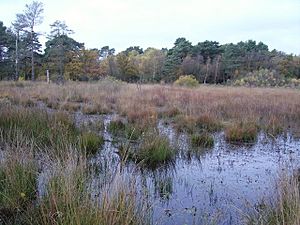Sandhurst to Owlsmoor Bogs and Heaths facts for kids
| Site of Special Scientific Interest | |
 |
|
| Area of Search | Berkshire |
|---|---|
| Interest | Biological |
| Area | 85.8 hectares (212 acres) |
| Notification | 1983 |
| Location map | Magic Map |
Sandhurst to Owlsmoor Bogs and Heaths is a special natural area in Berkshire, near Sandhurst. It's about 85.8 hectares (212 acres) big. This area is called a Site of Special Scientific Interest (SSSI) because it has important plants and animals.
Part of this SSSI is the Wildmoor Heath nature reserve. The Berkshire, Buckinghamshire and Oxfordshire Wildlife Trust helps look after it. This whole area is also part of the Thames Basin Heaths Special Protection Area. This means it's extra protected for its birds.
Contents
What is Sandhurst to Owlsmoor Bogs and Heaths?
Wildmoor Heath is on a gentle slope. It has different types of land. You can find wet and dry lowland heath here. There are also valley bogs, which are wet, spongy areas. Pine and broadleaved woodlands grow here too.
History of the Nature Reserve
In 1975, this site was officially named a Site of Special Scientific Interest (SSSI). This means it's a very important place for nature.
The Wildmoor Heath nature reserve was created in 1998. It brought together land from Edgbarrow Woods, Owlsmoor Bog, and Wildmoor Bottom.
Animals of Sandhurst to Owlsmoor Bogs and Heaths
This special area is home to many different animals.
Mammals Living Here
Reptiles and Amphibians
- Adder (a type of snake)
- Grass snake
- Slow worm (a legless lizard)
- Viviparous lizard
Birds You Might See
- Common chiffchaff
- Great spotted woodpecker
- European green woodpecker
- European nightjar
- Common snipe
- European stonechat
- Willow warbler
- Dartford warbler
- Woodlark
- Eurasian bullfinch
- Eurasian hobby
- Common kingfisher
Insects and Spiders
- Hairy dragonfly
- Common hawker
- Golden-ringed dragonfly
- Scarce chaser
- Keeled skimmer
- Beautiful demoiselle
- Banded demoiselle
- Emerald damselfly
- Red-eyed damselfly
- Large red damselfly
- Blue-tailed damselfly
- Common blue damselfly
- Azure damselfly
- Southern hawker
- Brown hawker
- Migrant hawker
- Emperor dragonfly
- Downy emerald
- Brilliant emerald
- Black-tailed skimmer
- Four-spotted chaser
- Black darter
- Ruddy darter
- Common darter
- Silver-studded blue (a butterfly)
- Stag beetle
- Raft spider
- Bog bush cricket
- Saturniinae (a type of moth)
- Wasp spider
Plants of Sandhurst to Owlsmoor Bogs and Heaths
Many different plants grow in this area.
Trees Growing Here
- Birch
- Pine
- Ash tree
- Maple
- Pedunculate oak
- Wild apple
- Wild service tree
Other Plants and Flowers
- Cross-leaved heath
- Purple moor-grass
- Round-leaved sundew
- Oblong-leaved sundew
- White beak-sedge
- Flea sedge
- Bog asphodel
- Common butterwort
- Heather
- Common cottongrass
- Devil's-bit scabious
- Lesser skullcap
- Marsh St John's wort
- Ragged-robin
- Devil's-bit scabious

